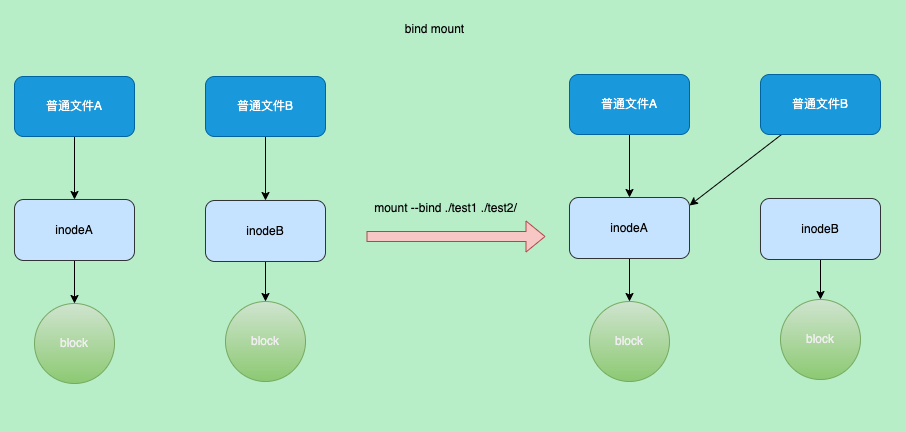containerd源码-snapshots
snapshots主要负责存储解压层之后的存储
代码版本为v.17.5
snapshot和content的结构类似,其接口定义如下
接口定义
// snapshots/snapshotter.go
type Snapshotter interface {
Stat(ctx context.Context, key string) (Info, error)
Update(ctx context.Context, info Info, fieldpaths ...string) (Info, error)
Usage(ctx context.Context, key string) (Usage, error)
Mounts(ctx context.Context, key string) ([]mount.Mount, error) // 只是返回了mount参数并没有真正的mount
Prepare(ctx context.Context, key, parent string, opts ...Opt) ([]mount.Mount, error) // 创建snap
View(ctx context.Context, key, parent string, opts ...Opt) ([]mount.Mount, error) // 和commit一样只不过是只读的
Commit(ctx context.Context, name, key string, opts ...Opt) error // 提交
Remove(ctx context.Context, key string) error // 删除
Walk(ctx context.Context, fn WalkFunc, filters ...string) error
Close() error
}snapshot grpc类型
- 注册插件,他依赖于service类型,同样实现了Register方法调用了grpc进行api注册服务
// services/snapshots/service.go
func init() {
plugin.Register(&plugin.Registration{
Type: plugin.GRPCPlugin,
ID: "snapshots",
Requires: []plugin.Type{
plugin.ServicePlugin,
},
InitFn: newService,
})
}
func newService(ic *plugin.InitContext) (interface{}, error) {
plugins, err := ic.GetByType(plugin.ServicePlugin)
if err != nil {
return nil, err
}
p, ok := plugins[services.SnapshotsService]
if !ok {
return nil, errors.New("snapshots service not found")
}
i, err := p.Instance()
if err != nil {
return nil, err
}
ss := i.(map[string]snapshots.Snapshotter)
return &service{ss: ss}, nil
}
func (s *service) Register(gs *grpc.Server) error {
snapshotsapi.RegisterSnapshotsServer(gs, s)
return nil
}- snapshot的service有个map,因为snapshotter有很多实现,比如默认的
overlayfs还有devmapper等
type service struct {
ss map[string]snapshots.Snapshotter
}- 我们看下其中一个api的实现,主要是处理grpc的请求和响应操作,需要注意的是传入的参数中有
Snapshotterid,然后执行对应的snap的api,后面就到了service层处理
func (s *service) Prepare(ctx context.Context, pr *snapshotsapi.PrepareSnapshotRequest) (*snapshotsapi.PrepareSnapshotResponse, error) {
log.G(ctx).WithField("parent", pr.Parent).WithField("key", pr.Key).Debugf("prepare snapshot")
sn, err := s.getSnapshotter(pr.Snapshotter)
var opts []snapshots.Opt
if pr.Labels != nil {
opts = append(opts, snapshots.WithLabels(pr.Labels))
}
mounts, err := sn.Prepare(ctx, pr.Key, pr.Parent, opts...)
return &snapshotsapi.PrepareSnapshotResponse{
Mounts: fromMounts(mounts),
}, nil
}snapshot service类型
- 依赖MetadataPlugin类型吗,调用
db.Snapshotters()拿到snap,meterdata里通过NewDB()传值
func init() {
// services/snapshots/snapshotters.go
plugin.Register(&plugin.Registration{
Type: plugin.ServicePlugin,
ID: services.SnapshotsService,
Requires: []plugin.Type{
plugin.MetadataPlugin,
},
InitFn: func(ic *plugin.InitContext) (interface{}, error) {
m, err := ic.Get(plugin.MetadataPlugin)
db := m.(*metadata.DB)
ss := make(map[string]snapshots.Snapshotter)
for n, sn := range db.Snapshotters() {
ss[n] = newSnapshotter(sn, ic.Events)
}
return ss, nil
},
})
}- 实际调用了metedata的
Prepare(),这里进行了大量的数据库操作
func (s *snapshotter) Prepare(ctx context.Context, key, parent string, opts ...snapshots.Opt) ([]mount.Mount, error) {
mounts, err := s.Snapshotter.Prepare(ctx, key, parent, opts...)
if err := s.publisher.Publish(ctx, "/snapshot/prepare", &eventstypes.SnapshotPrepare{
Key: key,
Parent: parent,
}); err != nil {
return nil, err
}
return mounts, nil
}- 这可以可以看到prepare和view实现都是一样的只不过view是只读的
- 源码很长这里不放了,其主要在数据存记录snap相关信息
- 随后调用真正的snap实现
// containerd/metadata/snapshot.go
func (s *snapshotter) Prepare(ctx context.Context, key, parent string, opts ...snapshots.Opt) ([]mount.Mount, error) {
return s.createSnapshot(ctx, key, parent, false, opts)
}
func (s *snapshotter) View(ctx context.Context, key, parent string, opts ...snapshots.Opt) ([]mount.Mount, error) {
return s.createSnapshot(ctx, key, parent, true, opts)
}
func (s *snapshotter) createSnapshot(ctx context.Context, key, parent string, readonly bool, opts []snapshots.Opt) ([]mount.Mount, error) {
// 校验参数以及复制等代码略过
if readonly {
m, err = s.Snapshotter.View(ctx, bkey, bparent, bopts...)
} else {
m, err = s.Snapshotter.Prepare(ctx, bkey, bparent, bopts...)
}
}snapshot类型
- 直接返回了
overlay.NewSnapshotter()
// snapshots/overlay/plugin/plugin.go
func init() {
plugin.Register(&plugin.Registration{
Type: plugin.SnapshotPlugin,
ID: "overlayfs",
Config: &Config{},
InitFn: func(ic *plugin.InitContext) (interface{}, error) {
ic.Meta.Platforms = append(ic.Meta.Platforms, platforms.DefaultSpec())
config, ok := ic.Config.(*Config)
root := ic.Root
if config.RootPath != "" {
root = config.RootPath
}
ic.Meta.Exports["root"] = root
return overlay.NewSnapshotter(root, overlay.AsynchronousRemove)
},
})
}- New函数中依然执行opt相关的操作,然后创建了目录随后创建数据库文件到这个目录中,注意这个数据库不metedata的数据库而是snap自己的数据库
- 读取了一些overlay相关参数
// snapshots/overlay/overlay.go
func NewSnapshotter(root string, opts ...Opt) (snapshots.Snapshotter, error) {
var config SnapshotterConfig
for _, opt := range opts {
if err := opt(&config); err != nil {
return nil, err
}
}
if err := os.MkdirAll(root, 0700); err != nil {
ms, err := storage.NewMetaStore(filepath.Join(root, "metadata.db"))
if err := os.Mkdir(filepath.Join(root, "snapshots"), 0700); err != nil && !os.IsExist(err) {
return nil, err
}
// figure out whether "userxattr" option is recognized by the kernel && needed
userxattr, err := overlayutils.NeedsUserXAttr(root)
if err != nil {
logrus.WithError(err).Warnf("cannot detect whether \"userxattr\" option needs to be used, assuming to be %v", userxattr)
}
return &snapshotter{
root: root,
ms: ms,
asyncRemove: config.asyncRemove,
indexOff: indexOff,
userxattr: userxattr,
}, nil
}- 和前面调用的PrePare结构很相似,也只是传递的是否只读不一样
func (o *snapshotter) Prepare(ctx context.Context, key, parent string, opts ...snapshots.Opt) ([]mount.Mount, error) {
return o.createSnapshot(ctx, snapshots.KindActive, key, parent, opts)
}
func (o *snapshotter) View(ctx context.Context, key, parent string, opts ...snapshots.Opt) ([]mount.Mount, error) {
return o.createSnapshot(ctx, snapshots.KindView, key, parent, opts)
}- 首先创建一个临时目录然后数据中创建snap记录,如果有parent则修改guid,然后修改名字为正式的snap目录
- 最后通过mount函数返回
// snapshots/overlay/overlay.go
func (o *snapshotter) createSnapshot(ctx context.Context, kind snapshots.Kind, key, parent string, opts []snapshots.Opt) (_ []mount.Mount, err error) {
if err := o.ms.WithTransaction(ctx, true, func(ctx context.Context) (err error) {
td, err = o.prepareDirectory(ctx, snapshotDir, kind)
s, err = storage.CreateSnapshot(ctx, kind, key, parent, opts...)
if len(s.ParentIDs) > 0 {
st, err := os.Stat(o.upperPath(s.ParentIDs[0]))
stat := st.Sys().(*syscall.Stat_t)
if err := os.Lchown(filepath.Join(td, "fs"), int(stat.Uid), int(stat.Gid)); err != nil {}
}
path = filepath.Join(snapshotDir, s.ID)
if err = os.Rename(td, path); err != nil {
return fmt.Errorf("failed to rename: %w", err)
}
td = ""
return nil
}); err != nil {
return nil, err
}
return o.mounts(s), nil
}
}- mount函数根据snapshotter的ParentIDs来判断是否返回读写的bind类型挂载
- 通过判断是否是active来返回只读的bind类型挂载
- 最后通过ParentIDs组合overlay的参数
// snapshots/overlay/overlay.go
func (o *snapshotter) mounts(s storage.Snapshot) []mount.Mount {
if len(s.ParentIDs) == 0 {
// if we only have one layer/no parents then just return a bind mount as overlay
// will not work
roFlag := "rw"
if s.Kind == snapshots.KindView {
roFlag = "ro"
}
return []mount.Mount{
{
Source: o.upperPath(s.ID),
Type: "bind",
Options: []string{
roFlag,
"rbind",
},
},
}
}
options := o.options
if s.Kind == snapshots.KindActive {
options = append(options,
fmt.Sprintf("workdir=%s", o.workPath(s.ID)),
fmt.Sprintf("upperdir=%s", o.upperPath(s.ID)),
)
} else if len(s.ParentIDs) == 1 {
return []mount.Mount{
{
Source: o.upperPath(s.ParentIDs[0]),
Type: "bind",
Options: []string{
"ro",
"rbind",
},
},
}
}
parentPaths := make([]string, len(s.ParentIDs))
for i := range s.ParentIDs {
parentPaths[i] = o.upperPath(s.ParentIDs[i])
}
options = append(options, fmt.Sprintf("lowerdir=%s", strings.Join(parentPaths, ":")))
return []mount.Mount{
{
Type: "overlay",
Source: "overlay",
Options: options,
},
}
}bind mount
- bind的mount类型是linux内核实现的一种挂载他和链接(
link)实现的功能很像,但是他实现更底层在vfs之下 - 参数rbind表示目录下的目录递归挂载到而不是这是这个一个,
- ro则表示只读

- bind相当于修改了文件的inode到挂载的目录上

mkdir test1 test2
ls -li
# 总用量 0
# 34260425 drwxr-xr-x 2 root root 6 10月 31 17:32 test1
# 50339286 drwxr-xr-x 2 root root 6 10月 31 17:32 test2
mount --bind ./test1 ./test2/
ll -ti
# 总用量 0
# 34260425 drwxr-xr-x 2 root root 6 10月 31 17:32 test1
# 34260425 drwxr-xr-x 2 root root 6 10月 31 17:32 test2
echo "foo"> ./test1/test
cat ./test2/test
# foo
# 显示的挂载是vda1而是test1
mount -l |grep test
# /dev/vda1 on /data/test/test2 type xfs (rw,relatime,attr2,inode64,noquota)参考
https://blog.csdn.net/weixin_40864891/article/details/107330218